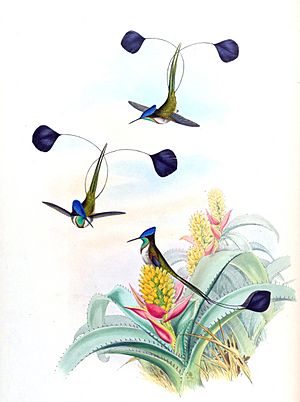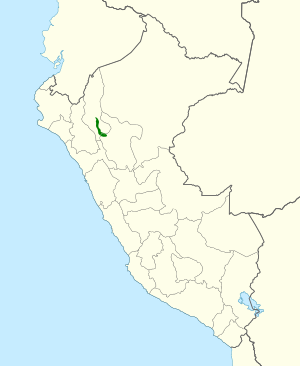Marvelous spatuletail facts for kids
The marvelous spatuletail (Loddigesia mirabilis) is a very special and rare hummingbird. It's known for its amazing tail feathers, especially the male's. This bird lives only in a small part of northern Peru and is considered an endangered species. This means there aren't many left, and they need our help to survive.
Quick facts for kids Marvelous spatuletail |
|
|---|---|
 |
|
| Loddigesia by John Gould | |
| Conservation status | |
| Scientific classification | |
| Genus: |
Loddigesia
|
| Species: |
mirabilis
|
 |
|
| Distribution of Loddigesia mirabilis in Peru | |
Contents
About the Marvelous Spatuletail
The marvelous spatuletail is a unique hummingbird. It's the only bird in its group, called Loddigesia. Scientists are always learning more about birds. Sometimes, they find new information that changes how birds are grouped together.
What Does It Look Like?
The male marvelous spatuletail is a truly stunning bird! It measures about 15 to 17 centimeters (6 to 7 inches) long. A big part of this length is its incredible tail, which can be 11 to 13 cm (4 to 5 in) long. The male's most famous feature is its two long outer tail feathers. These feathers have bare stems that cross each other. At the end of each stem is a large, purplish-black, round shape, like a paddle or "spatula." The rest of its tail feathers are very short.
Female spatuletails are smaller, about 9 to 10 cm (3.5 to 4 in) long. Their tails are also long, but not as long as the males', and they don't have the special "spatulas."
Both male and female spatuletails have a slightly curved black beak. They also have a small white spot right behind their eyes.
Colors of the Spatuletail
Male spatuletails have mostly green feathers on their upper body. They have a bright blue crest on their head and a brownish color on the back of their neck. The feathers on their throat, called a gorget, are a shiny blue-green. The rest of their belly is white with a black line down the middle.
Female spatuletails are also green on top. However, they don't have the blue crest or the shiny throat patch. Their underparts are white, and they don't have the black line that males have.
Where Does It Live?
The marvelous spatuletail lives only in a small area of northern Peru. Most of these birds are found in the valley of the Utcubamba River. This area is in a region called Amazonas Department. A few have also been seen a bit further east in the Department of San Martín.
This hummingbird likes to live on the edges of forests. It can be found in older forests, forests that are growing back, and mountain scrublands. It especially likes areas with thick bushes of thorny Rubus plants and alder trees (Alnus). These birds usually live at elevations between 2,100 and 2,900 meters (6,900 to 9,500 feet) high.
How It Behaves
Movement and Daily Life
The marvelous spatuletail stays in its home area all year long. It doesn't migrate to other places.
What It Eats
The marvelous spatuletail finds its food by visiting a regular path of flowering plants. This is called "trap-lining." It will perch on a flower to drink its nectar. It is most often seen feeding from a red-flowered lily called Bomarea formosissima. However, it also feeds from at least five other types of flowering plants. Sometimes, other hummingbird species that live in the same area might try to chase it away from food sources.
Reproduction and Breeding
Scientists don't know a lot about how the marvelous spatuletail reproduces. It seems their breeding season is usually between December and February. However, it might sometimes last from October to May.
Male spatuletails gather in special areas called leks. Here, they perform amazing aerial dances to attract females.
Sounds It Makes
During its aerial display, the male marvelous spatuletail makes a high-pitched, buzzing, metallic sound. It sounds like "tzzz...tzzz..." It also has calls that sound like a sweet, rising note, "tswee," and a sharper sound, "tsik."
Protecting the Marvelous Spatuletail
The IUCN (International Union for Conservation of Nature) has changed its rating for the marvelous spatuletail over the years. Since 2000, it has been listed as Endangered. This means it faces a very high risk of becoming extinct in the wild.
It's only found in two main areas, and scientists believe there are fewer than 1,000 adult birds left. One big problem for these birds is deforestation, which is when forests are cut down. Even though the spatuletail likes forest edges, losing too much forest is still a threat. Sadly, male spatuletails are sometimes hunted for traditional purposes.
Good news! In 2005, an organization called American Bird Conservancy helped a Peruvian group, ECOAN. They worked with the local community to protect about 100 acres of important habitat for the marvelous spatuletail. This was the first time such a conservation agreement happened in Peru! More than 30,000 young native trees and bushes have been planted there to help the birds.
Marvelous Spatuletail in Media
This amazing bird has been featured on several TV shows. It appeared on the PBS series Nature. It was also shown on two BBC TV series: Natural World and Life.
Images for kids
-
Loddigesia by John Gould
See also
 In Spanish: Colibrí cola de espátula para niños
In Spanish: Colibrí cola de espátula para niños




